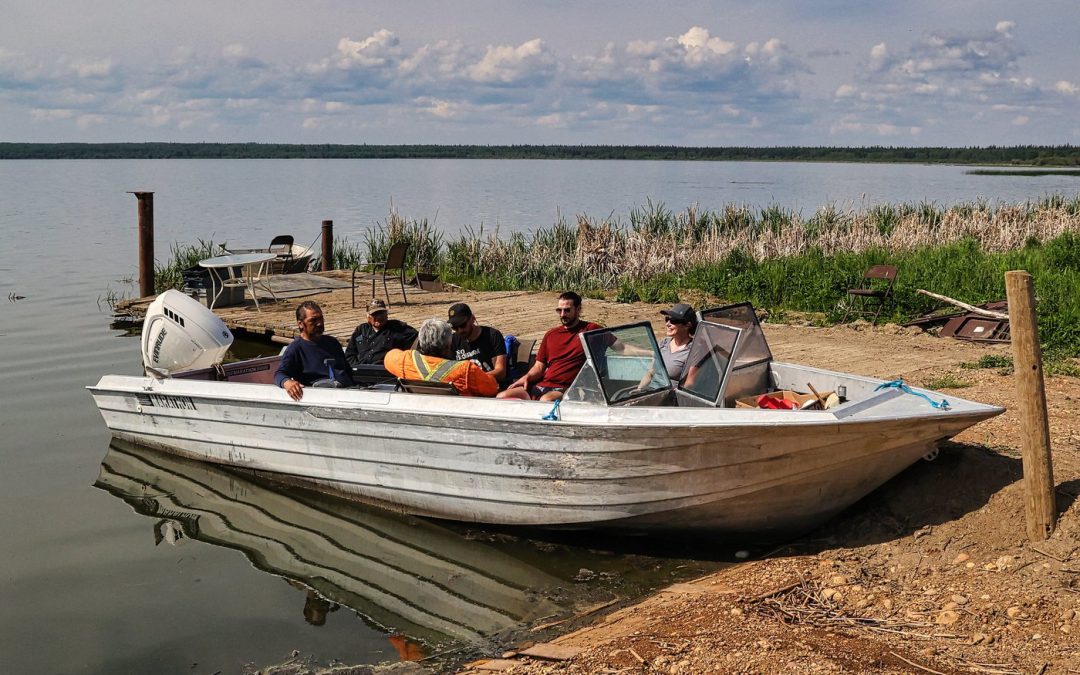Photo: Community members alongside scientists prepare to collect sediment samples from a lake scarred by historic oil contamination / Photo submitted by: Fabian Grey
By Sonal Gupta
Local Journalism Initiative Reporter
Canada’s National Observer
After decades burdened by oil spills and environmental damage, an Alberta First Nation is pushing back — not against resource development, but for a fair share of industry profits to restore land scarred by these projects.
Whitefish Lake First Nation, situated in the boreal forests of northern Alberta, borders vast oil fields that have long shaped and worn down its territory. “It’s not just the land that’s sick — our people are sick too, because our health is tied to the health of the land,” said Fabian Grey, the nation’s consultation manager.
Poverty persists across many First Nations despite funding they receive from various government agencies, he said. Whitefish Lake is not seeking compensation, but rather a fair “piece of the pie” from the wealth generated on their territories.
“Every major project that comes through our traditional land use area… billions of dollars go out of the province, out of our traditional land use areas and then to overseas. But it doesn’t stay here with us,” he said.
The scars from decades of spills and unchecked development are etched into the land — lakes once teeming with life are now contaminated and fragile. Fishing grounds that were once abundant yield brittle catches, tainted by mercury that limits safe consumption. “In years past, we could fish the rivers with a hand net and fill a box,” Grey said. “Today, you’re lucky to get half that, and we’re only eating one fish a week because of contamination.”
Wildlife has also suffered. The elk population has plummeted from around 3,200 to roughly 1,000 animals per 100 square kilometers across an area of about 5,400 square kilometres.
Cameras along animal trails revealed how species adapt or struggle with industrial disruption. Wolves and lynx often avoid pipelines but linger near well sites where prey thrive; moose shy away from roads, well sites and recent logging areas. Community members have long observed that all of these disturbances make the land less habitable.
Cuts to federal and provincial funding have stalled their monitoring and restoration efforts. “We don’t have the funding to sustain these programs ourselves,” Grey said.
Community leaders say the situation could improve with a share of profits from resource projects. Darren Auger, the nation’s councillor, recognizes that oil and gas are the economic lifeblood for the community. “We support oil and gas; it’s a big part of our economy,” he said. “If we’re stopping oil and gas in Canada, somebody else is going to be producing.”
More often than not, pipelines receive approval. “Because that’s where we get our paycheques from,” Grey said.
Their nation wants a significant role in managing and benefiting from development, which must come with environmental stewardship. It now has the technology to monitor environmental impacts on former oil and gas sites, as well as machines that detect soil contaminants, Auger said. The gear helps them assess the effectiveness of cleanup efforts and confirm whether the land has been fully restored.
Grey said that if Indigenous communities were on an equal footing with developers, they would ensure that land disturbed by industrial projects is balanced by the restoration or protection of an equivalent amount of land elsewhere.
Thousands of abandoned wells, he added, remain untouched because pipeline companies do not view them as their responsibility, and restoring them could return vast areas of land to healthier and more usable conditions. The Whitefish Lake nation envisions would like to use resource project revenue to help remediate orphaned wells, restore damaged ecosystems and bolster monitoring programs managed by Indigenous hands.
First Nations across the country remain divided on the issue of major projects. Many chiefs at a recent Winnipeg meeting rejected a resolution giving the Assembly of First Nations (AFN) authority to negotiate with the federal government on fast-tracking laws for major projects, including First Nations infrastructure under Bill C-5. They argued the resolution lacked guarantees for proper consultation and Indigenous rights, insisting negotiations should be direct and nation-to-nation, not through the AFN which advocates but does not hold Indigenous rights.
Grey echoed the position. He said the AFN can’t adequately represent the needs and concerns of members, particularly in western provinces. Indigenous voices must be heard individually to properly address their distinct environmental, economic and cultural realities.
AFN National Chief Cindy Woodhouse Nepinak acknowledged the issue’s complexity and regional differences. She told Canada’s National Observer that the AFN has met with Alberta chiefs multiple times and will continue to do so to better reflect their priorities, noting that more details and plans will emerge at upcoming assemblies. “We want to be partners in sustainable growth and prosperity for all, but not at the expense of our rights or the environment,” Nepinak said.
Grey said the goal should not be to halt projects, but to enforce stricter environmental standards informed by Indigenous perspectives, particularly in forestry and resource extraction, since current practices are unsustainable for their community today and in future.
“We are so dependent on Western society to sustain us, and we can’t go back to the way we were living. We have to preserve what we know the best we can,” he said.
